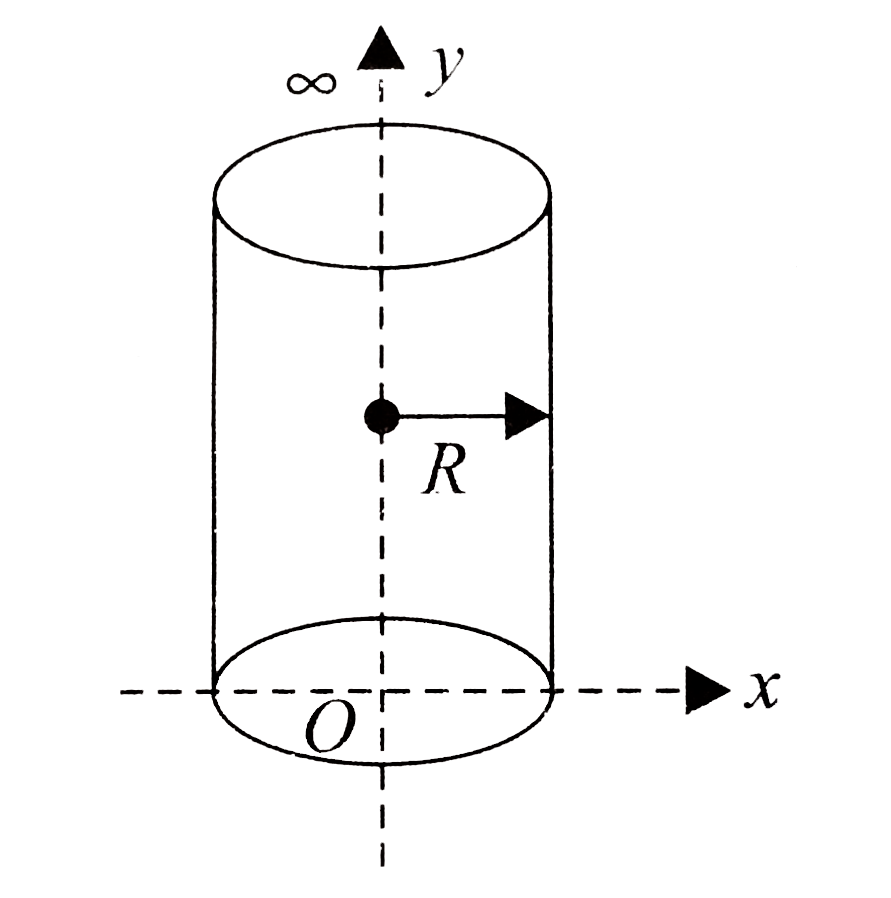The current density is a solid cylindrical wire a radius R, as a function of radial distance r is given by J(r)=J0(1−rR) . The total current in the radial regon r = 0 to r=R4 will be :
5J0πR232
5J0πR296
3J0πR264
J0πR3128
The correct Answer is:B
To solve the problem, we need to calculate the total current flowing through a cylindrical wire with a given current density function. The current density J(r) is defined as:
J(r)=J0(1−rR)
where J0 is a constant, r is the radial distance from the center of the cylinder, and R is the radius of the cylinder.
1. Define the Elemental Area:
The elemental area dA of a cylindrical shell at radius r with thickness dr is given by:
dA=2πrdr
2. Define the Elemental Current:
The elemental current dI through this area can be expressed as:
dI=J(r)dA=J0(1−rR)⋅(2πrdr)
3. Set Up the Integral for Total Current:
To find the total current I from r=0 to r=R4, we integrate dI:
I=∫R/40dI=∫R/40J0(1−rR)(2πrdr)
4. Simplify the Integral:
Substitute J0 and 2π outside the integral:
I=2πJ0∫R/40(1−rR)rdr
5. Expand the Integrand:
The integrand can be expanded:
I=2πJ0∫R/40(r−r2R)dr
6. Calculate the Integral:
Now, calculate the integral:
I=2πJ0(∫R/40rdr−1R∫R/40r2dr)
The integrals can be computed as:
∫R/40rdr=(r22)R/40=(R/4)22=R232
∫R/40r2dr=(r33)R/40=(R/4)33=R3192
7. Substitute Back into the Total Current Expression:
Substitute these results back into the expression for I:
I=2πJ0(R232−1R⋅R3192)
Simplifying this gives:
I=2πJ0(R232−R2192)
8. Combine the Terms:
To combine the fractions, find a common denominator (which is 192):
R232=6R2192
Thus,
I=2πJ0(6R2192−R2192)=2πJ0⋅5R2192
9. Final Expression for Total Current:
Therefore, the total current is:
I=10πJ0R2192=5πJ0R296
Conclusion:
The total current in the radial region from r=0 to r=R4 is:
I=5πJ0R296
The elemental area dA of a cylindrical shell at radius r with thickness dr is given by:
dA=2πrdr
The elemental current dI through this area can be expressed as:
dI=J(r)dA=J0(1−rR)⋅(2πrdr)
To find the total current I from r=0 to r=R4, we integrate dI:
I=∫R/40dI=∫R/40J0(1−rR)(2πrdr)
Substitute J0 and 2π outside the integral:
I=2πJ0∫R/40(1−rR)rdr
The integrand can be expanded:
I=2πJ0∫R/40(r−r2R)dr
Now, calculate the integral:
I=2πJ0(∫R/40rdr−1R∫R/40r2dr)
The integrals can be computed as:
∫R/40rdr=(r22)R/40=(R/4)22=R232
∫R/40r2dr=(r33)R/40=(R/4)33=R3192
Substitute these results back into the expression for I:
I=2πJ0(R232−1R⋅R3192)
Simplifying this gives:
I=2πJ0(R232−R2192)
To combine the fractions, find a common denominator (which is 192):
R232=6R2192
Thus,
I=2πJ0(6R2192−R2192)=2πJ0⋅5R2192
Therefore, the total current is:
I=10πJ0R2192=5πJ0R296
The total current in the radial region from r=0 to r=R4 is:
I=5πJ0R296
Similar Questions
A cylindrical wire of radius R has current density varying with distance r form its axis as J(x)=J0(1−r2R2) . The total current through the wire is
View SolutionA current is flowing through a cylinderical conductor of radius R, such that current density at any cross-section is given by J=J0(1−rR), where r is radial distance from axis of the cylinder .Calculate the total current through the cross-section of the conductor.
View SolutionA solid ball of radius R has a charge density ρ given by ρ=ρ0(1−rR)for0≤r≤R The electric field outside the ball is :
View SolutionThe current density in a wire of radius a varies with radial distance r as J=J0r2a, where J0 is a constant. Choose the incorrect statement.
View SolutionThe current density across a cylindrical conductor of radius R varies in magnitude according to the equation J=J0(1−rR) where r is the distance from the central axis. Thus, the current density is a maximum J0 at that axis (r = 0) and decreases linearly to zero at the surface (r = R). Calculate the current in terms of J0 and the conductor 's cross - sectional area A=πR2.
View SolutionThe mass density of a planet of radius R varie with the distance r form its centre as ρ(r)=p0(1−r2R2). Then the graviational field is maximum at :
View SolutionThe current density ¯¯¯J inside a long, solid cylindrical wire of radius a=12mm is in the direction of the central axis, and its magnitude varies linearly with radial distance r from the axis according to J=J0ra, where J0=1054πA/m2. Find the magnitude of the magnetic field at r=a2 in μT
View SolutionThe current density ¯¯¯J inside a long, solid cylindrical wire of radius a=12mm is in the direction of the central axis, and its magnitude varies linearly with radial distance r from the axis according to J=J0ra, where J0=1054πA/m2. Find the magnitude of the magnetic field at r=a2 in μT
View SolutionCurrent density in a cylindrical wire of radius R is given as J=⎧⎪⎨⎪⎩J0(xR−1) for 0≤x<R2J0xR for R2≤x≤R.
If the current flowing in the wire is k12πJ0R2, find the value of k.
View SolutionAn infinite cylindrical wire of radius R and having current density varying with its radius r as, J=J0[1−(r/R)]. Then answer the following questions.

Graph between the magnetic field and radius is
View Solution
